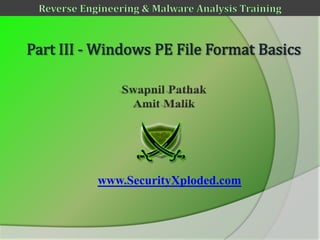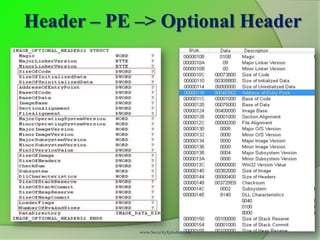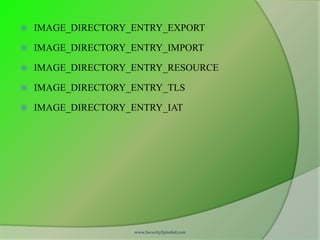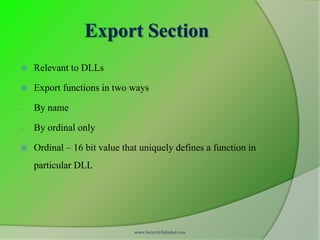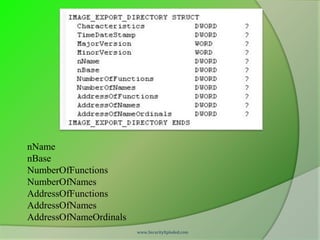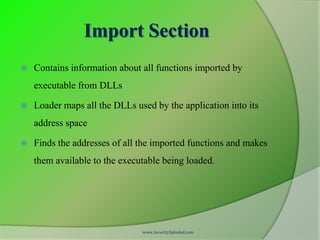Reversing & malware analysis training part 3 windows pe file format basics
- 2. Disclaimer The Content, Demonstration, Source Code and Programs presented here is "AS IS" without any warranty or conditions of any kind. Also the views/ideas/knowledge expressed here are solely of the trainer’s only and nothing to do with the company or the organization in which the trainer is currently working. However in no circumstances neither the trainer nor SecurityXploded is responsible for any damage or loss caused due to use or misuse of the information presented here. www.SecurityXploded.com
- 3. Acknowledgement Special thanks to null & Garage4Hackers community for their extended support and cooperation. Thanks to all the trainers who have devoted their precious time and countless hours to make it happen. www.SecurityXploded.com
- 4. Reversing & Malware Analysis Training This presentation is part of our Reverse Engineering & Malware Analysis Training program. Currently it is delivered only during our local meet for FREE of cost. For complete details of this course, visit our Security Training page. www.SecurityXploded.com
- 5. Who am I #1 Amit Malik (sometimes DouBle_Zer0,DZZ) Member SecurityXploded & Garage4Hackers Security Researcher RE, Exploit Analysis/Development, Malware Analysis Email: m.amit30@gmail.com www.SecurityXploded.com
- 6. Who am I #2 Swapnil Pathak Member SecurityXploded Security Researcher RE, Malware Analysis, Network Security Email: swapnilpathak101@gmail.com www.SecurityXploded.com
- 7. PE File Format PE – Portable Executable PE is the native Win32 file format. 32-bit DLL, COM, OCX, Control Panel Applets(.CPL), .NET, NT kernel mode drivers are all PE File Format. www.SecurityXploded.com
- 8. Why PE File Format How windows loader loads the executable in memory. How loader build the import and export table for a module in memory From where to start the execution or Address of entry point Answer of the question “how binary compiled on a version of windows works on another version of windows?” Where should attacker attack Also today’s malwares are generally encrypted, packed. In order to rebuild the original binary we need to know how the binary is structured. www.SecurityXploded.com
- 9. Basic Structure www.SecurityXploded.com
- 10. Basic Structure Cont. Most common sections found in executable are Executable Code section (.text , CODE) Data Sections (.data, .rdata, .bss, DATA) Resources section (.rsrc) Export Section (.edata) Import Section (.idata) Debug Information Section (.debug) www.SecurityXploded.com
- 11. Headers – DOS Header All PE files start with DOS header First 64 bytes of the file. Run program in DOS. Runs the DOS stub Usually the string “This program must be run under Microsoft Windows” e_lfanew is the pointer to PE or NT header Structure defined in windows.inc or winnt.h www.SecurityXploded.com
- 12. Header- DOS header cont. e_magic = 4D, 5A (MZ) e_lfanew is a DWORD which contains the offset of the PE header www.SecurityXploded.com
- 13. Headers – PE header Begins with signature (DWORD) 50h, 45h, 00h, 00h Letters “PE” followed by two terminating zeros File Header- 20 Bytes – contains info about physical layout and properties of the file Optional Header- 224 Bytes – contains info about the logical layout of the PE file – size given by member of File header www.SecurityXploded.com
- 14. Headers – PE –> File header Machine NumberOfSections SizeOfOptionalHeader Characteristics www.SecurityXploded.com
- 15. Header – PE –> Optional Header www.SecurityXploded.com
- 16. Optional Header Cont. AddressOfEntryPoint ImageBase SectionAlignment FileAlignment SizeOfImage SizeOfHeaders Subsystem DataDirectory www.SecurityXploded.com
- 17. Header – PE –> Optional –> Data Directory Last 128 bytes of OptionalHeader Array of 16 Image_Data_Directory structures Each relating to an important data structure like the Import Table Members Virtual Address : RVA of the data structure iSize : size in bytes of the data structure www.SecurityXploded.com
- 18. Data Directories www.SecurityXploded.com
- 19. IMAGE_DIRECTORY_ENTRY_EXPORT IMAGE_DIRECTORY_ENTRY_IMPORT IMAGE_DIRECTORY_ENTRY_RESOURCE IMAGE_DIRECTORY_ENTRY_TLS IMAGE_DIRECTORY_ENTRY_IAT www.SecurityXploded.com
- 20. Headers - Section Header Array of IMAGE_SECTION_HEADER Equal to the numberofsections – FileHeader member. Each structure size = 40 bytes www.SecurityXploded.com
- 21. Section Header cont. Name – Virtually can be anything in text VirtualSize – Size of section in memory VirtualAddress – section entry offset in memory (RVA) SizeOfRawData – Size of section on disk PointerToRawData – section entry offset on disk Characteristics – Type of section (execuatble, data etc.) Section Alignment and File Alignment are two important values from optional header that control the entry point of next section. www.SecurityXploded.com
- 22. The structure of PE file on disk is exactly the same as when it is loaded into memory. The windows loader maps the required sections in memory. When sections are loaded into memory they are aligned to fit 4KB memory pages (Section Alignment), each section starting on a new page. www.SecurityXploded.com
- 23. Type of PE file sections Executable code Data Resources Export section Import section Thread Local Storage (TLS) Base Relocations (reloc.) www.SecurityXploded.com
- 24. Export Section Relevant to DLLs Export functions in two ways - By name - By ordinal only Ordinal – 16 bit value that uniquely defines a function in particular DLL www.SecurityXploded.com
- 25. nName nBase NumberOfFunctions NumberOfNames AddressOfFunctions AddressOfNames AddressOfNameOrdinals www.SecurityXploded.com
- 26. Export by Ordinal only Export Forwarding www.SecurityXploded.com
- 27. Import Section Contains information about all functions imported by executable from DLLs Loader maps all the DLLs used by the application into its address space Finds the addresses of all the imported functions and makes them available to the executable being loaded. www.SecurityXploded.com
- 28. Import Directory 20 byte structure IMAGE_IMPORT_DESCRIPTOR Number of structures = Number of DLLs imported Last structure filed with zeros www.SecurityXploded.com
- 29. OriginalFirstThunk Name1 FirstThunk Hint Name1 www.SecurityXploded.com
- 30. Each IMAGE_THUNK_DATA str corresponds to one imported function from the dll. Arrays pointed by OriginalFirstThunk and FirstThunk run parallelly. OriginalFirstThunk – Import Name Table – Never modified FirstThunk – Import Address Table – Contain actual function addresses www.SecurityXploded.com
- 31. Functions exported by ordinal only - No IMAGE_IMPORT_BY_NAME structure -IMAGE_THUNK_DATA contains the ordinal of the function -MSB used to identify the same - MSB is set, rest 31 bits are treated as an ordinal value. -Bound Imports www.SecurityXploded.com
- 33. Reference Complete Reference Guide for Reversing & Malware Analysis Training www.SecurityXploded.com
- 34. PE file format test Write a program in “C” or “ASM” that will modify the Address of Entry point of an Executable (.exe) file with any random address. Write a program in “C” or “ASM” that will add a new section into an executable (.exe) For hints shoot us an email www.SecurityXploded.com

